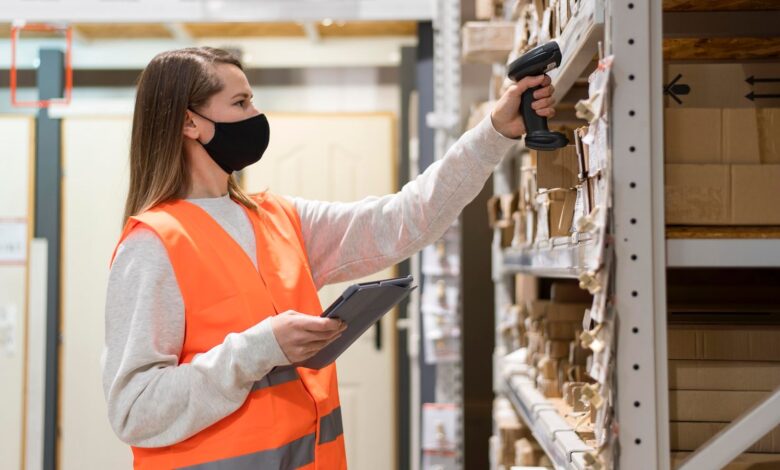2024 Expert Guide of Warehouse Monitoring: Systems, Trends & Techniques

In the last few years, warehouses have Warehouse Monitoring: Systems earned the significant advantage of quantum leap all around the world. E-commerce warehouses have involved a lot of activities. Monitoring daily tasks like order fulfilment and inventory receiving to more complex activities makes managing everything happening within your facility hard.
Effective warehouse management technology needs reliable, correct, real-time information on warehousing functions. Warehouse monitoring is important for brands with deep visibility and up-to-date information to maximise brand operational efficiency and how to get things done in your warehouse.
Continue reading this to learn about warehouse monitoring, the latest trends in warehouse management technology, and the future of warehouse management technology.
Contents
What is Warehouse Monitoring?
Warehouse monitoring adds Internet of Things or IoT technology to the brand facility to provide real-time and up-to-date data from assets and equipment. Within a warehouse, it is a central tool for measuring, observing, and tracking the conditions and activities.
Real-time data can help brands run smoothly. The brand uses warehouse monitoring to manage the environment, assets, energy, problems, and inventory.
Smart warehouse technology is used in warehouse monitoring to gather, process, and intercept data. This will help the employee act on insight and make decisions. Acumatica, Aptean, and Blue Link are the best warehouse management systems.
Warehouse Monitoring Latest Trends to Lookout in 2024
What advancements do we need to make in 2024 and beyond? Let’s discuss the latest trends in warehouse management that are making warehouses more efficient, safe, and greener.
Growing Imperative of Green Housing
Greenhousing is the warehouse idea that embraces the number of growing businesses. The idea is that warehouses prioritise minimising waste, ecological impacts, and energy consumption.
Studies show that warehouses contribute 11% of the total greenhouse gases produced by the global logistics industry. Green housing helps in redusing this figure improves the bottom line of business.
How Businesses Embrace Green Housing
Worldwide forward-thinking warehouses are adopting a range of strategies to reduce environmental impact. Here are some effective of them:
- Renewable energy sources
- Optimised transportation
- Energy-efficient lighting
- Eco-friendly packaging
RFID Technology Use Increases
RFID (Radio-frequency Identification): what is it? It refers to wireless, which consists of tags and a reader. This technology uses electromagnetic fields to identify tags attached to warehouse items. Compared to barcoding, these items are automatically tracked and identified as they enter, move, or exit the warehouse.
There are four most effective ways that RFID technology can be used to enhance warehouse processes like improving accuracy and saving time when:
- Receiving Stock
- Monitoring inventory
- Stock location optimisation
- Dispatching orders
Benefits Of Rfid Technology For Warehouses
Research shows that RFID technology boosts inventory accuracy by an average of 65% to more than 95%. RFID technology reduces the risk of human error when scanning, receiving stock, and dispatching orders.
It helps to prevent decreasing inventory loss by enabling tighter control and monitoring of inventory movements.
The Rise Of AI-Powered Warehouses
AI is fastly being installed in many warehouse processes to unlock efficiencies and insight that looked impossible a few years ago.
Research shows more than 38% of logistics and manufacturing companies are using AI, which benefits them by reducing budgets by up to 50% in logistics. AI helps warehouses quickly analyse and ensure they have the right amount of stock available. It uses up-to-date data to deliver predictive insights that help the packing process, supply trends, and deliveries.
How AI is Helping Warehouses
Let’s look at some ways that AI is used to provide predictive insights to optimise processes:
- Anticipating demand
- Inventory optimisation
- Predictive picking
- Predictive maintenance
- Delivery route optimisation
- Supply chain analysis
Warehouse robots are nothing new, but they are becoming more quick and effective with time. We are now shifting to robots from robotic arms that take away the heavyweight of warehouse workers.
Techniques for Warehouse Monitoring
The following are the techniques for warehouse monitoring:
Barcode Scanning
Barcodes are used extensively in warehouses for inventory tracking. Barcode scanners can quickly scan barcodes on products and shelves to update inventory records and track movement within the warehouse.
IoT Sensors
Internet of Things (IoT) sensors can be used throughout the warehouse to monitor various environmental conditions, such as temperature, humidity, and light levels. These sensors can help ensure optimal storage conditions for different types of goods and alert warehouse managers to deviations from set parameters.
Warehouse Management Systems (WMS)
WMS software platforms integrate data sources such as RFID, barcode scanners, and IoT sensors to provide comprehensive warehouse monitoring and management capabilities. These systems offer features such as inventory tracking, order management, and real-time analytics.
Video Surveillance
Video cameras strategically placed throughout the warehouse can visually monitor inventory, equipment, and personnel. Advanced video analytics can be used to detect anomalies, track movements, and enhance security.
Predictive Analytics
By analysing historical data and current trends, predictive analytics algorithms can forecast future demand, identify potential inventory shortages, and optimise warehouse operations. This enables proactive decision-making and resource allocation.
Mobile Applications
Mobile applications can provide warehouse managers and staff with real-time access to inventory data, task assignments, and performance metrics from anywhere within the facility. These applications enhance communication and efficiency on the warehouse floor.
Cloud Computing
Cloud-based warehouse monitoring solutions offer scalability, flexibility, and accessibility. By leveraging cloud computing infrastructure, warehouse operators can store and process large volumes of data, collaborate across locations, and integrate with other business systems.
Machine Learning and AI
Machine learning algorithms can analyse warehouse data to identify patterns, optimise workflows, and improve decision-making. AI-powered systems can automate repetitive tasks, predict equipment maintenance needs, and optimise inventory replenishment strategies.
Geofencing
Geofencing technology uses GPS or RFID to create virtual boundaries around specific areas within the warehouse. By setting up geofences, warehouse managers can track the movement of assets, enforce safety protocols, and automate inventory management processes.
How Does Prolog Fulfilment Help You With It?
For warehouse efficiency, warehouse setup plays an important role. Due to your layout, people and vehicles can run smoothly and, ultimately, your warehouse operations. With Prolog Fulfilment, you can optimise your warehouse layout, ultimately affecting your work efficiency.



